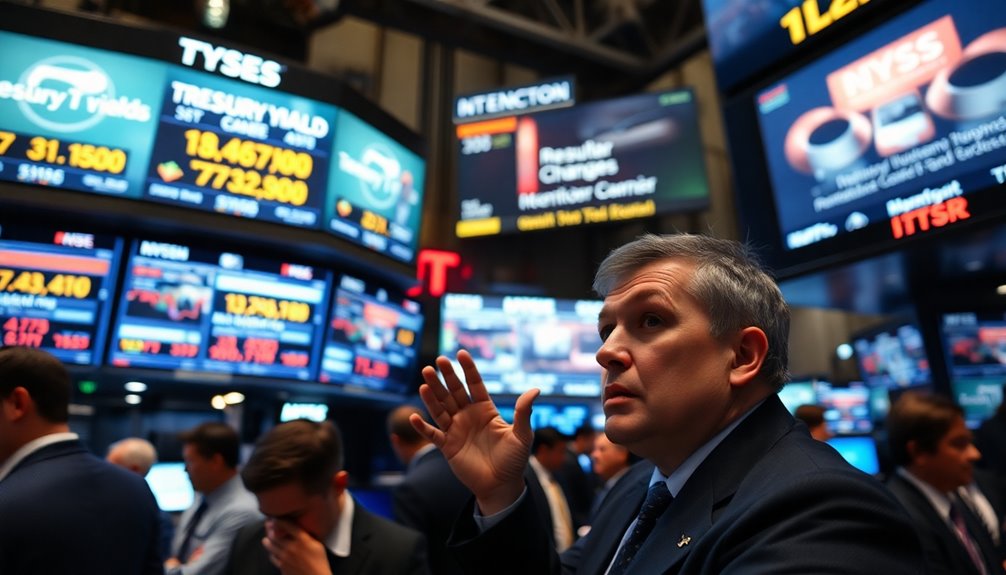With rising Treasury yields hitting 4. 79%, you’re feeling the pressure as markets react to shifting economic conditions. The S&P 500 has slipped into negative territory, adding to the jitters ahead of the Federal Reserve’s upcoming decisions. Anticipation surrounding CPI data only heightens this uncertainty, as inflation remains a key concern. Additionally, global factors, like soaring U. K. gilt yields, reinforce the volatile landscape. As you navigate these turbulent waters, you’ll want to keep an eye on interest rate projections and regulatory changes that could further shape your investment strategy in the near future. In this context, the recent Coindesk 20 market decline overview provides additional insight into the broader financial landscape, as cryptocurrencies are also feeling the impact of these economic pressures. Investors are increasingly cautious, weighing potential risks against opportunities in both traditional and digital assets. As you develop your strategy, staying informed on market trends and expert analyses will be crucial to navigating this challenging environment effectively.
Key Takeaways
- Rising Treasury yields at 4.79% are increasing pressure on stock markets, contributing to heightened volatility.
- Anticipation of upcoming CPI data is creating uncertainty among investors, leading to cautious market behavior.
- Historical trends show volatility spikes around Federal Reserve announcements, intensifying current market jitters.
- The S&P 500 has entered negative territory, reflecting investor concerns about economic conditions and interest rates.
- Global bond market reactions, including soaring U.K. gilt yields, indicate a broader impact on financial markets ahead of the Fed meeting.
Market Volatility Ahead of Decisions

As market participants brace for key economic decisions, volatility is increasingly prevalent, driven largely by rising Treasury yields and shifting inflation expectations.
With the 10-year Treasury yield hitting 4.79%, you might feel the pressure on stocks intensifying. Higher yields raise borrowing costs, making equities less attractive. The S&P 500's slip into negative territory reflects this shift, while global bond markets also react, as seen with U.K. gilt yields soaring to 4.925%. In recent years, historical data shows that QV increases tend to spike around Fed announcements, influencing market reactions.
You should keep an eye on the upcoming CPI data, as any surprise could spark further volatility.
Investors are anxious about how the Fed will respond, especially as inflationary pressures loom larger.
These dynamics create an uncertain landscape, keeping you on your toes in the market.
Regulatory Changes Impacting Markets

Market volatility isn't just influenced by economic data; regulatory changes are also reshaping how financial institutions operate.
With the implementation of Basel III in the EU, you'll see enhanced disclosure standards coming into play, requiring financial institutions to disclose key metrics starting January 1, 2025. This aims to improve transparency and consistency in reporting. Furthermore, solvent exit requirements for non-systemic banks are due by October 2025, further emphasizing the importance of regulatory compliance.
Additionally, the EU Digital Operational Resilience Act (DORA) will take effect on January 17, 2025, ensuring that firms can respond effectively to disruptions.
In the crypto space, the EU's Markets in Cryptoassets Regulation (MiCAR) will fully apply by December 30, 2024, streamlining oversight.
These regulatory shifts demand your attention, as they'll impact market dynamics significantly.
Inflation Rates and Consumer Spending

Though inflation rates have shown slight fluctuations, consumer spending patterns are adapting in response to these economic changes. As inflation in the U.S. rose to 2.7% in November 2024, you might notice a shift in how you and others prioritize spending. Analysts expect core inflation to stabilize around 3.3% in the coming months, influencing consumer confidence. Understanding budget management can help you navigate these shifts more effectively.
With global consumer spending expected to increase by 6% in 2025, there's a clear emphasis on value and discounts. While concerns about the job market linger, you're likely becoming more intentional in your purchases.
Despite inflation easing, high interest rates keep you cautious. Research firms project a total increase of $3.2 trillion in global consumer spending next year, highlighting a deliberate approach to navigating these economic uncertainties.
Adapting your spending habits could become essential for financial stability.
Crypto Integration in Portfolios

While navigating the complexities of modern investing, integrating cryptocurrencies into your portfolio can enhance diversification and potential returns. To minimize risk, consider diversifying across various coins and sectors, including DeFi and gaming. Investing in publicly traded companies that embrace blockchain technology can also provide indirect exposure to the crypto market. Diversification can reduce overall portfolio risk, allowing you to better manage the inherent volatility of cryptocurrencies. Additionally, employing dollar-cost averaging can help mitigate the impacts of price fluctuations. Regularly review your portfolio to monitor performance and rebalance as needed, ensuring optimal diversification.
Elections Shaping Economic Policies

Investors must consider how upcoming elections will influence economic policies that could reshape market dynamics.
Changes in immigration policy might tighten or expand the labor market, impacting job growth and wages. For instance, increased competition for jobs could arise from deregulation efforts that ease hiring foreign workers. The Republican Party's regained control of the Senate could lead to significant shifts in these policies.
Tax policy, including potential cuts for corporations and individuals, could boost spending but also raise concerns about the federal deficit.
Meanwhile, trade policies, such as tariffs, might protect domestic industries but could also lead to higher consumer prices and inflation.
Therefore, as political candidates outline their platforms, the uncertainty they create may delay business investments and hiring decisions, prompting investors to stay vigilant about policy shifts.
Interest Rate Projections Ahead

As the Federal Reserve gears up for potential rate cuts in 2025, it's crucial to understand how these changes could affect your financial landscape.
Analysts predict the Fed will reduce interest rates three more times, lowering the key borrowing benchmark to between 3.5% and 3.75%. This means cheaper borrowing costs for you, with credit card rates likely falling to an average of 19.8%. Average credit card APR is projected to decline from the current 20.27% by the end of 2025.
As the Fed meets regularly to adjust rates, consider how these shifts might influence your loans and investments.
With GDP growth expected to hover around 1.5% to 2%, keeping an eye on inflation projections will also help you navigate the evolving economic environment.
Stay informed; it's your financial future at stake.
Frequently Asked Questions
How Do Treasury Yields Affect Mortgage Rates for Consumers?
Treasury yields significantly impact mortgage rates for you as a consumer. When the 10-year Treasury yield rises, mortgage rates often increase too, since investors shift their focus.
Higher yields generally mean higher borrowing costs, making mortgages less affordable. The difference between these rates typically reflects the risk associated with mortgage-backed securities.
What Are the Implications of CPI Data on Stock Market Performance?
CPI data can significantly impact stock market performance.
When CPI rises, it often leads to higher interest rates, which can dampen consumer spending and reduce corporate earnings. You might see stock prices drop as companies struggle with increased costs.
Conversely, if CPI suggests strong economic growth, you could witness a boost in stock prices.
Ultimately, staying informed on CPI trends helps you make better investment decisions and navigate market fluctuations effectively.
How Do Global Events Influence U.S. Treasury Yields?
Global events significantly influence U.S. Treasury yields.
When you see strong GDP growth or low unemployment, yields often rise as investors seek higher returns.
Conversely, economic uncertainty or geopolitical tensions might lead you to favor government bonds, lowering yields.
Inflation rates also play a crucial role; higher inflation can push yields down as investors demand compensation.
Essentially, you need to stay alert to how these global dynamics shift market sentiment and yield expectations.
What Strategies Can Investors Use to Hedge Against Inflation?
To hedge against inflation, you can consider a few effective strategies.
Start by investing in Treasury Inflation-Protected Securities (TIPS) for stable returns.
Diversify your portfolio with real assets like real estate and commodities, which tend to perform well during inflation.
You might also want to look at stocks with pricing power, such as consumer staples, and explore alternative investments like private real estate for added protection and potential returns.
How Often Does the Federal Reserve Update Its Economic Outlook?
The Federal Reserve updates its economic outlook eight times a year during its Federal Open Market Committee (FOMC) meetings.
After each meeting, you'll find the Summary of Economic Projections (SEP) released, detailing forecasts for GDP growth, unemployment rates, and inflation.
These updates reflect participants' assessments based on current data and assumptions, helping you understand the Fed's monetary policy stance and potential economic risks.
Stay informed to make better investment decisions!
Conclusion
As the market dances on a tightrope, uncertainties swirl like autumn leaves caught in a gust. With the Fed looming ahead, every whisper of inflation and shift in yields sends ripples through your portfolio. This is a time to stay sharp, eyes wide, as the financial landscape shifts beneath your feet. Prepare for the storms of regulatory change and the gusts of election winds—your savvy navigation could turn today's jitters into tomorrow's opportunities.









